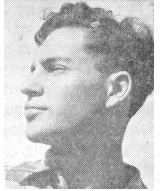
David Guenther Livingston, the son of Freda and Joseph, was born in Breslau in Germany on 11th September 1919. After arrival in the USA he became a citizen and served in the military.
When Aliyah Bet ships were attempting to break the British blockade around the shores of Israel, he was one of those who volunteered to fight the blockade and sailed on a number of successful voyages.
While serving as a crew member of the ship “Chaim Arlosoroff,” the ship was intercepted by the Royal Navy and the passengers and crew were interned in Cyprus. He arrived in Israel at the beginning of 1945, and immediately joined in the struggle as a fighter in the Palmach Yiftach Brigade.
He fell in the defense of Kibbutz Mishmar Ha’Emek on 13th April 1948. He was laid to rest in the military section of the Afula cemetery.
Source: Translated from the Yizkor website by Joe Woolf,
Three Gravestones, Two Bodies, One Grave
The Disappearance of David Livingston
On 13th April 1948, following the battle of Mishmar Ha’Emek, the bodies of three fallen soldiers were brought to Afula Hospital. They were members of the 22nd Battalion of the Carmeli Brigade. Two were identified by name, whereas the third was buried under the name Avraham Ben Avraham (Abraham son of Abraham), as was the common practice in case of unidentified fallen soldiers.
David Livingston was born in New York. He volunteered to serve in the Haganah as a seaman on vessels that brought Holocaust survivors to Eretz Israel, then Palestine. Livingston served on two such voyages. The first was the vessel “Chaim Arlosoroff” which encountered the British Navy near Haifa bay on 27th February 1947 and the survivors and crew redirected to Cyprus. It is not clear how long Livingston stayed in Cyprus but on 6th September 1947 he was sent to Venice to join the crew of the Atzmaut (Hebrew for “Independence”) which headed directly for Cyprus, where it arrived on 1st January 1948.
In 1958 Livingston’s brother came to Israel to look for his brother’s gravesite. He met a man who had met David in Cyprus and claimed to have seen him again in Israel not long before the battle of Mishmar Ha’Emek. He identified him as the corpse that had been buried at Afula cemetery. Based on this information, the Chief Military Rabbi Shlomo Goren authorized that the name on the gravestone of Avraham ben Avraham would be changed to David Livingston. Livingston is listed on the Army “Yizkor” list as having served in the Palmach Yiftach Brigade.
Based on that, Livingston’s name was added to the list of the fallen soldiers of Machal Aliyah Bet, the foreign volunteers (as listed in the World Machal and Palyam websites).
Yosef Kochan immigrated to Eretz Israel on board the vessel Latrun which was intercepted and the survivors were redirected to Cyprus. At the beginning of 1948 he joined the battle of Mishmar Ha’Emek. His family was notified only about two weeks later. When the War of Independence ended the family wanted to visit the gravesite and was surprised to learn that the site is unknown. In 1955-56, following futile search and frustration, he was recognized by the Ministry of Defense as “Missing in Action” and his name was added to the list of “Missing in Action” at Mount Herzl in Jerusalem. But his relatives and friends from the 22nd Battalion contested the decision and demanded that the coffin buried in Afula be re-opened to verify the identity. After about 50 years the IDF relented and authorized a DNA verification. The findings indicated that the corpse was indeed that of Yosef Kochan, and the gravestone was modified accordingly.
After 65 years the question of where David Livingston is buried remains unanswered. His status is that of “Missing in Action”. Other questions remain open. At the end of February 1947 Livingston was in Cyprus. What did he do until September 1947? In the Operations Log of the Aliyah Bet Mossad in Paris it was noted on 5th September 1947: “To the ship in Venice I send the “Sami” (the American) Livingston directly”. It is known that he reached Constance, Romania, on board that vessel (Pan Crescent then renamed Atzmaut). Had he continued the voyage to Famagusta, Cyprus? Did his serve in the Yiftach Brigade in April 1948?

On board the “Atzmaut”: The Commander Berchik on the left. David Livingston on the right

David Livingston
Source: Palyam website: www.palyam.org

